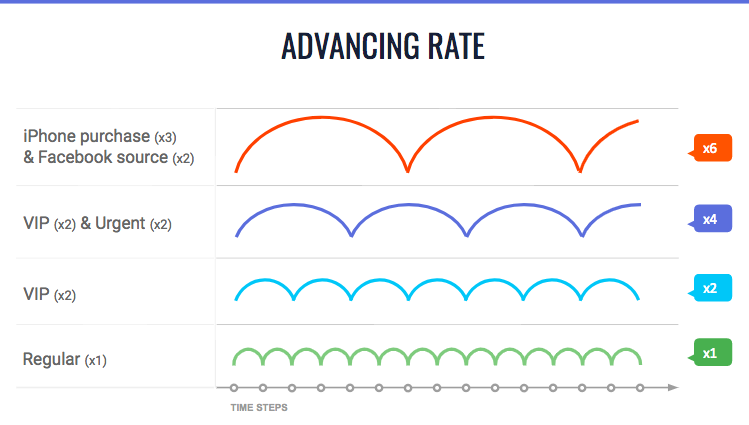Queue prioritization overview
Queue prioritization focuses agent resources on the conversations that matter most. It allows brands to efficiently allocate staffing resources and better handle incoming messages by prioritizing conversations in the queue based on importance.
Benefits of queue prioritization
Handle more conversations - By prioritizing interactive conversations first you can drive more conversations towards a resolution.
Allocate staff efficiently - Efficiently allocate staffing resources and better handle incoming messages by prioritizing conversations in queues based on importance.
Align business strategy and define which consumers you answer first - Use business rules and select the most suitable prioritization approach according to your brands needs and strategy.
Increase customer satisfaction for the consumers that matter most to you - Increase customer satisfaction by lowering wait times on high priority skills.
What does queue prioritization do?
The new prioritization algorithm allows brands to choose a custom blend of prioritization approaches for driving more actionable conversations towards a resolution. The approaches are:
- Queue entrance time - Give priority to conversations according to their entrance time into the queue.
- Conversation interactiveness - Give priority to conversations where the consumer has just written a message and therefore is considered more interactive.
Brands can also define their own business rules that dictate which conversations to prioritize based on the number of transfers the conversation has been through or by assigning a higher priority to conversations that are being transferred to or from a specific skill.
Brands can choose their prioritization strategy, not only by the time of the day, but also by the day of the week. This enables brands to handle situations such as conversations that come in during the weekend, only after the Monday morning rush has been taken care of.
Queue prioritization use cases
Handle the night queue after handling the morning peak
When the queue size is big, for example during the mornings hours, handle fresh conversations of users that contacted the center once the shift started, rather than handling the conversations that stacked up during the night. Once the morning peak is over, handle the consumers that approached the brand during the night.
Prioritize conversations that were transferred to a retention skill
Define a business rule that assigns higher priority to conversations that were transferred to a retention skill.
Prioritize conversations that were escalated by a bot
Define a business rule that assigns higher priority to conversations that were transferred from a bot skill enabling your human agents to quickly bring back the conversation on its course.
Prioritize conversations based on consumer authenticated attributes
Tailor queue prioritization business rules based on authenticated consumer attributes. This way, you can define that customers with high account balances or those marked as VIP’s receive a velocity factor that helps them advance faster in the queue - reducing the response time for these consumers.
Prioritize conversations based on skills
Brands can prioritize conversations based on the skills hierarchy. This means if there is a skill which is considered to be of high priority, e.g. a sales skill, it can be defined as high priority and ensured that those conversations are handled first.
Prioritize conversations based on incoming messaging source
Brands can prioritize queues based on the messaging source of the incoming conversation. For example, if WhatsApp conversations have been identified as having higher conversion rates, brands can decide to prioritize WhatsApp conversations in the queue.
Prioritize conversations that were previously sent back to queue
Conversations being placed back into queue (though they have already waited to receive an agent assignment) can be automatically assigned higher priority and reach the top of queue faster, improving consumer experience by ensuring no consumer needs to wait longer just because their conversation was returned to queue.

What to expect after enabling this feature?
- Wait time for high priority skills would be reduced
- Wait time for low priority skills would increase
- Average time to resolve issues would be reduced
- Number of handled conversations would increase
- CSAT/ MCS of prioritized customers increase
- CSAT/MCS of other customers may decrease
Arriving at the desired configuration
Understand the Queue Prioritization cycle
Queue Prioritization runs every 2 seconds and prioritizes the conversations in the queue based on the prioritization approach that was drawn for the cycle.
The prioritization approach is drawn according to a predefined probability defined when configuring the feature.
Derive the configuration
The Queue Prioritization configuration is built out of a list of rules that are derived from business questions.
Answer the following questions to arrive at the desired configuration:
- What is the percentage of prioritization cycles in which you would like to prioritize based on Conversation Interactiveness?
- Are there any conversations you would like to assign a higher priority when transferred to or from a specific skill?
- After how many transfers of a conversation would you like to assign it a higher priority for handling?
- Would you like to change the prioritization approach based on the time of day or queue size?
- Are there any conversations you would like to assign with higher priority in case the consumers are from a specific customer tier or have specific engagement attributes (customer info or personal info)?
How to configure
LivePerson account teams must configure the queue prioritization for their customers.
Missing Something?
Check out our Developer Center for more in-depth documentation. Please share your documentation feedback with us using the feedback button. We'd be happy to hear from you.